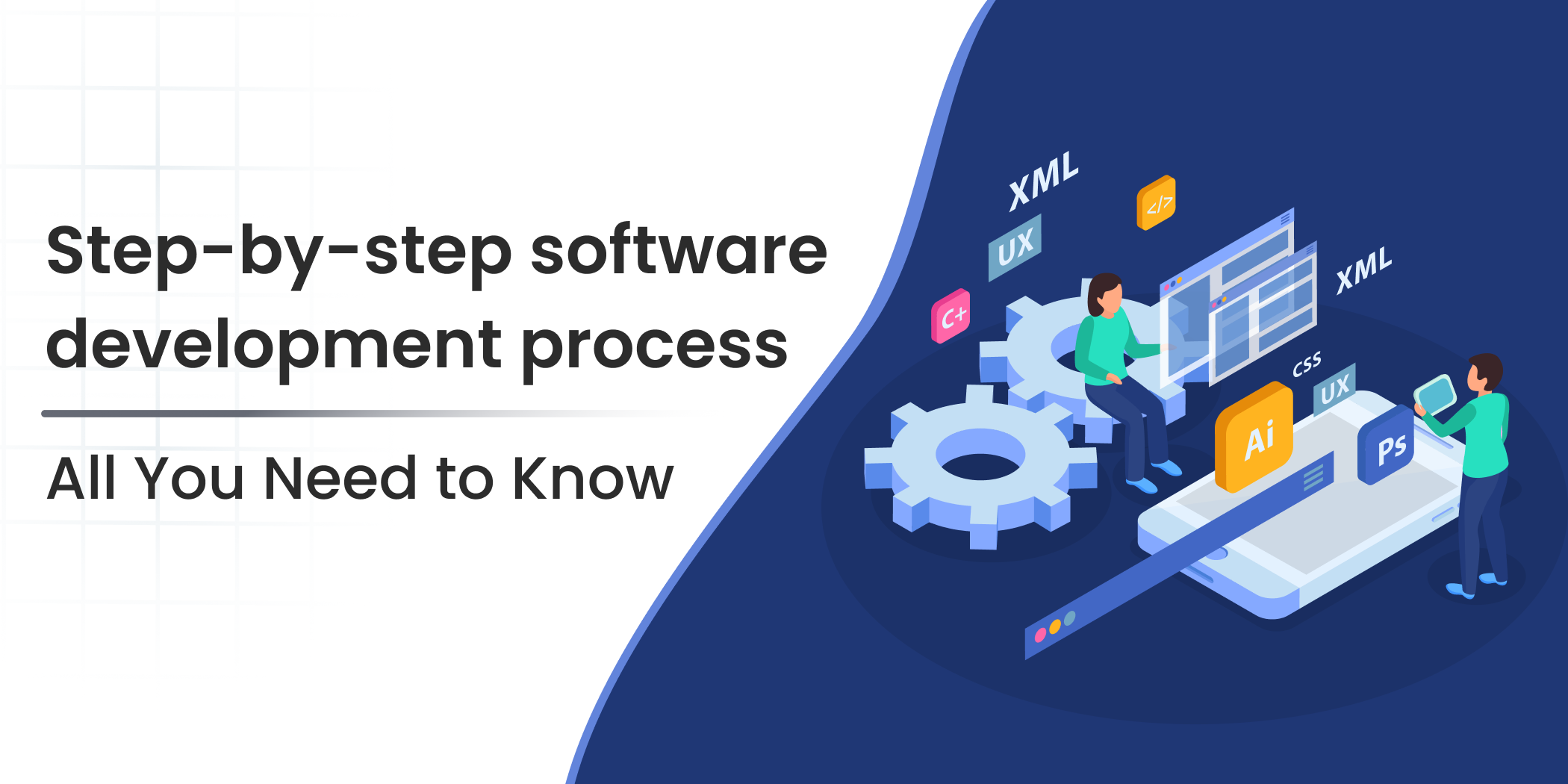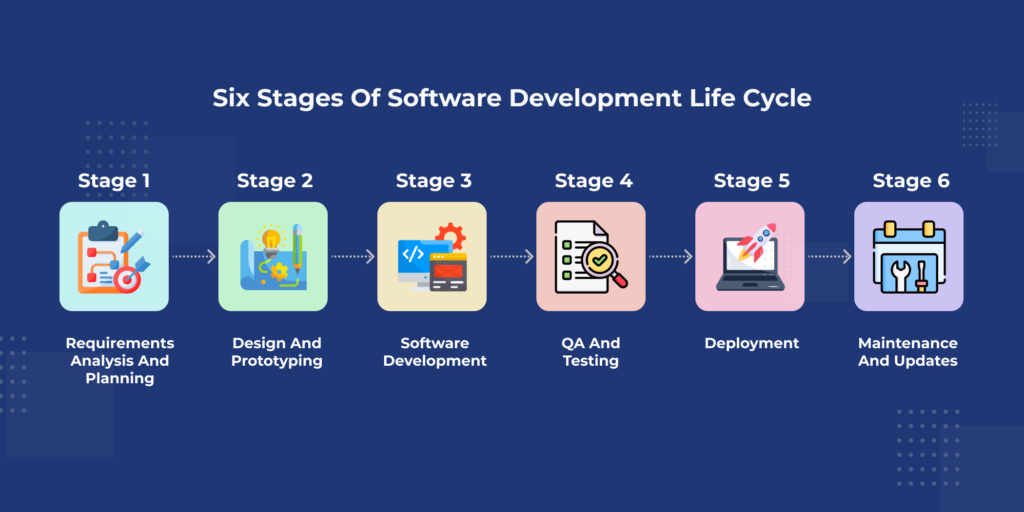A List of The 25 Best Ruby on...
May 8, 2024
Home >> Software >> Step-by-step software development process: All You Need to Know

Quick Summary
Software development is comprised of well-defined and organized processes. Its ultimate purpose is to create a programmed product to fulfil a business’s objectives. A team of software developers working together to generate computer code produced the software product. However, it also includes various tasks from the software design process, like requirement analysis, research, planning, data and process flow design, thorough testing, technical documentation development, debugging, and deployment.
For this reason, you should know the steps involved in software creation to learn more about software development process
One must learn about the software development lifecycle as soon as possible.
The numerous stages of software development during its lifetime are included in the Software Development Life Cycle (SDLC). The software development life cycle, a process for producing high-quality software, is composed of a set of predefined processes.
Furthermore, the entire software design process will only be successful if all the steps are addressed.
The software development life cycle consists of multiple parts. Some of these phases are obtaining requirements, designing, developing, testing, delivering, and maintaining the product.
On the other hand, when a committed group of experts is hired, every step of the software product development process becomes their responsibility.
Furthermore, regardless of the software development methodology being used, the steps in the software design process remain the same.
Now that you know what the acronym SDLC means, you can go on to understand the relevance of the software development life cycle.
Let’s examine the potential benefits the software development life cycle (SDLC) approach could offer your business.

The software development team must gather the company’s demands in this initial stage before generating a broad concept for any product.
The requirement collection and analysis phase is another name for this stage. Compiling a list of the precise specifications needed by any program under consideration is the most crucial task for the project managers and other stakeholders. Many questions need to be asked now, some of which are as follows:
Who is the intended audience for this program?
What is the software intended to be used for when it is finished?
What categories of data should be included in the software?
How much should be possible for this software to generate those data?
Once these essential questions have been answered, a generic design is created for the software engineers to focus on. After that, the data is examined to see if it is legitimate and if it is possible to include it. Creating a document for requirement definition is the last phase in the software development process. This paper serves as a manual for the next step in the procedure.
“Design,” the second stage of the software development process, is the following. Using the need criteria from the previous stage, the program’s draft design is created at this phase. With the help of the system designs, the hardware and requirements for the system can be established. It also helps in the process of defining a software architecture-related overall system.
The system’s design specifications serve as the input for the next stage of the software development life cycle. During this stage, the testers create test strategies by listing the items requiring testing and potential examination methods.
After the design documents for the software that will be produced have been received, the work that follows the design stage is divided into several distinct units and modules equally. This is the point in the process where the actual coding begins. The development team’s creation of error-free code is the primary goal of the phase under discussion. This specific step takes the longest out of the entire treatment.
To comprehend software development, you should always fully grasp the testing stage and also understanding the phases of the software development testing life cycle. The developers are currently dealing with a significant difficulty. If something goes wrong during the testing phase or any faults are found in the codes, it might be necessary to repeat the coding procedure. This process will be repeated until the desired outcome is achieved. This process phase encompasses all forms of functional testing, such as non-functional, unit, system, acceptance, integration, and so forth.
After testing and fixing any errors resulting from the coding processes, the fifth stage, the deployment stage, occurs. The program is either deployed or given to the clients so they can use it after the finalized code has been implemented. This final deployment step of the process of software development will occur once all the issues have been fixed and enhancements have been made.
Over time, real issues start to surface as users begin utilizing the carefully created product. That said, there’s no sign that the software may become corrupted. Conversely, it can regularly force the emergence of intermittent issues. This specific process concerns the final product or software item and is referred to as maintenance.
Need a trusted partner for your software project?
Connect with us today to discuss how our software development services can help you achieve your goals.
Numerous methods for the software development life cycle suitable for efficiently handling complicated projects are available. However, choosing the right one depends on many factors, such as the project’s requirements, size, team composition, business objectives, and end goals.
Let’s examine each SDLC method and approach in more detail now.
The waterfall model is one of the many traditional methods used in software development. When each step is completed at its designated stage, the project advances to the next one. The main benefit of the Waterfall model is that it allows you to assess each step’s viability and continuity before moving on to the next.
The goal of developing the agile paradigm was prioritising client requirements. This methodology’s primary goal will be the user’s experience and input. This resolves numerous problems with earlier software that could have been more challenging.
Furthermore, it improves the software’s ability to react appropriately to user feedback. One of the objectives of the agile methodology, which aims to adapt to changing market requirements, is the rapid release of software cycles. It needs a highly skilled staff with outstanding communication abilities.
Developers can quickly create a primary or initial software version using the iterative paradigm. Subsequently, they examine the software and gradually implement any required modifications to enhance it. This method is most frequently used in large software applications. It increases software capability, which is essential to achieving the company’s goals. However, this approach risks using resources that were not anticipated and has the potential to outgrow its scope quickly.
Throughout the entire software development life cycle (SDLC), from the design stage to the process of providing production support, information technology operations (Ops) and development teams (Dev) work together under the most crucial framework: the DevOps as a Service model.
To deploy DevOps, these teams within the company must communicate and work together constantly. Tools for continuous integration and delivery, also known as continuous deployment or CI/CD, are a component of DevOps, an approach that emphasizes work automation.
An idea for a software product is eventually realized through a sequence of iterative phases and a strategy known as the software development flow. It’s crucial to remember that, in the context of software development services, adhering to the preferred approach can help you, no matter how significant the project, prevent delays, lower risks, and make fewer mistakes throughout the software development life cycle (SDLC).
When you start designing a new piece of software, there are endless paths ahead. Please give it a moment, though. Inhale deeply and slowly a few times. It is crucial to remember that four fundamental concepts underpin every software development method and process. By doing this, you can prevent feeling overburdened.
Comprehend: Gain a thorough grasp of the purpose and scope of your project.
Create: Initiate the design and development stages of the software.
Validate: Distribute the software to users for real-time feedback and testing.
Refine: Utilize input to enhance and evolve the software product.
A well-functioning software development life cycle is necessary to provide a high-quality product that meets user needs. The requirements of the user and the solution to the main user problem should remain the central focus of the software development process, regardless of whether it is the flexible Agile methodology, also If you’re aiming for top-notch results, considering hire software developer to ensure excellence in your project’s outcomes. the conventional Waterfall technique, or any other methodology mentioned in the article.
Here you can see six main stages of the software development process requirements analysis, design, software development, testing, deployment, and maintenance to deliver the best software.
Design is very important in the process of software development because it involves creating different types of blueprints and models that outline how the software will function and look.

Digital Valley, 423, Apple Square, beside Lajamni Chowk, Mota Varachha, Surat, Gujarat 394101
+91 9913 808 2851133 Sampley Ln Leander, Texas, 78641
52 Godalming Avenue, wallington, London - SM6 8NW